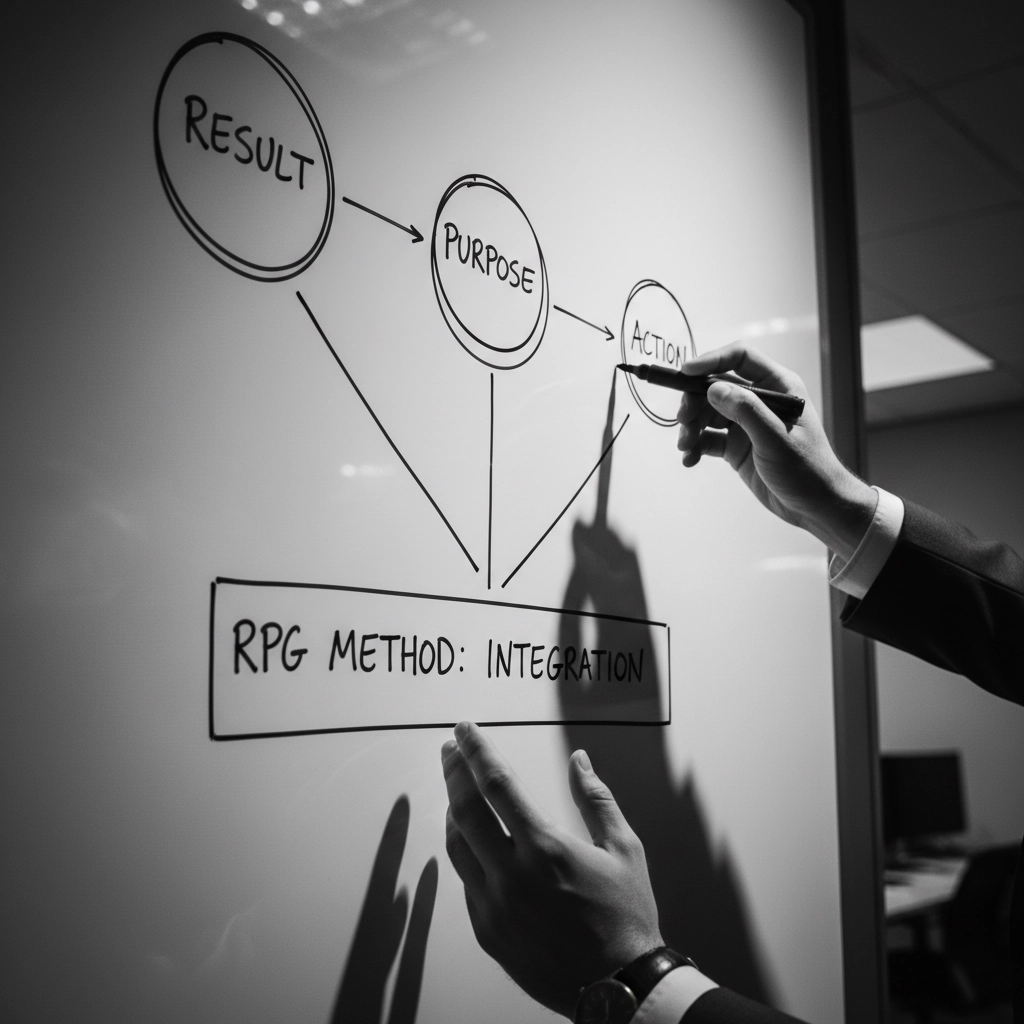How to Write Goals That Stick: The RPG Method for Executives
- Mark Mathia

- Sep 10
- 5 min read
Most executives I work with have a graveyard of abandoned goals. They start strong in January, create detailed strategic plans, and by March... well, you know how this story ends. The problem isn't lack of ambition or intelligence: it's using goal-setting methods that don't account for how our brains actually work.
After years of coaching high-capacity leaders in Omaha and beyond, I've found one approach that consistently creates breakthrough results: the RPG method. This isn't just another goal-setting framework: it's a complete system that aligns your deepest motivations with massive action to create unstoppable momentum.
What Is the RPG Method?
RPG stands for Result, Purpose, and massive Action. Unlike traditional goal-setting that focuses primarily on the "what," this method creates a three-dimensional approach that engages both your logical mind and emotional drivers.
Here's the visual layout that makes all the difference:

The power lies in the positioning. Your main goal sits in the center: your focal point. To the right, you capture your deep "why": the purpose that will pull you through obstacles. To the left, you map out the massive actions that will make it inevitable.
This isn't random placement. Research shows our brains process information spatially, and this arrangement creates both logical flow and emotional resonance.
The Three Components Explained
The Result (Center)
Your result isn't just any goal: it's a specific, measurable outcome that excites and slightly intimidates you. Great results have three characteristics:
They're specific and measurable. "Increase revenue" becomes "Generate $2.4M in revenue by December 31st." Vague intentions create vague results.
They stretch you beyond your comfort zone. If you're 100% certain you can achieve it, it's not big enough. The best goals require you to become someone new in the process of achieving them.
They align with your deeper values. Surface-level goals that don't connect to what you truly care about will always lose to more pressing urgent matters.
The Purpose (Right Side)
This is where most goal-setting fails. We skip the "why" and jump straight to tactics. But here's what I've learned: when the pain of staying where you are becomes greater than the pain of change, breakthrough happens.
Your purpose answers these questions:
Why does this goal matter to you personally?
What will achieving this create in your life?
Who will benefit beyond yourself?
What happens if you don't achieve this?
The most powerful purposes often combine personal fulfillment with service to others. "I want to grow my company to create better opportunities for my team and their families" carries more emotional weight than "I want to make more money."
Massive Action (Left Side)
This is where the rubber meets the road. Massive action isn't just "more action": it's the right actions taken with intensity and consistency.
Break this into three categories:
Daily non-negotiables: The minimum actions you'll take every single day, no matter what. These should be small enough that you can't fail, but significant enough that they compound over time.
Weekly power moves: Bigger actions that move the needle significantly. These might include key meetings, strategic decisions, or major project milestones.
Monthly breakthrough activities: The game-changing actions that create exponential results. These often involve stepping outside your comfort zone or making significant investments.
Step-by-Step Implementation
Step 1: Start with Clarity
Before you write anything, get clear on what you really want. Not what you think you should want, or what others expect from you, but what genuinely excites you.
Ask yourself: "If I could wave a magic wand and create any professional outcome in the next 12 months, what would it be?"
Step 2: Craft Your Result
Write your goal in the center of a page or whiteboard. Use this formula: "I will [specific action] by [specific date] as measured by [specific metrics]."
Example: "I will grow my company's annual revenue to $5.2M by December 31, 2026, as measured by monthly financial statements and confirmed by our CPA."
Step 3: Dig Deep for Purpose
On the right side, write your compelling reasons. Don't stop at the surface level. Keep asking "why" until you hit something that gives you chills.
Start with: "This goal matters to me because..." Then ask: "And why does that matter?" Keep going until you reach your core.
Step 4: Map Your Massive Action
On the left side, brainstorm every action that could contribute to your result. Then organize them into:
Daily disciplines (small but consistent)
Weekly power moves (significant progress)
Monthly breakthroughs (game-changers)
Be ruthless about identifying the vital few actions that will create 80% of your results.

Real-World Application for Executives
Let me share how Sarah, an HR Director here in Omaha, used this method to transform her career trajectory.
Her Result: "I will be promoted to VP of People Operations by June 30, 2026, with a compensation package of $180K+ and equity participation."
Her Purpose: "This promotion allows me to create systematic change that impacts every employee's experience. I want my team to know they're valued and have clear paths for growth. My own family will benefit from the increased security, and I'll model for my daughters that women can lead with both strength and compassion."
Her Massive Actions:
Daily: One strategic conversation with a key stakeholder
Weekly: Present one process improvement to leadership
Monthly: Complete one external professional development program
The result? She was promoted eight months ahead of schedule.
Why This Method Works When Others Fail
Traditional goal-setting treats your brain like a computer: input the goal, execute the plan. But we're not computers. We're emotional, social beings driven by both logic and feeling.
The RPG method works because it engages multiple motivational systems:
Visual processing: The spatial arrangement helps your brain organize and prioritize information more effectively.
Emotional engagement: The purpose component activates your deeper motivational centers, not just your logical mind.
Action orientation: Instead of hoping motivation will strike, you create specific behaviors that generate momentum.
Present-moment focus: Like the inner game approach, this method keeps you focused on what you can control right now, rather than worrying about everything that could go wrong.
The beauty is that once you have all three components clear, decision-making becomes easier. When faced with opportunities or distractions, you simply ask: "Does this align with my result, connect to my purpose, and qualify as massive action?"
Common Pitfalls and How to Avoid Them
Pitfall #1: Making your purpose too small. "I want to hit my sales target" isn't compelling enough to sustain you through tough months. Go deeper.
Pitfall #2: Overcomplicating the actions. You don't need 47 different tactics. Focus on the vital few that create exponential results.
Pitfall #3: Setting it and forgetting it. Review your RPG weekly. Adjust actions as needed, but keep your result and purpose steady.
Pitfall #4: Going it alone. Share your RPG with someone who will hold you accountable. External accountability multiplies internal commitment.
Your Next Move
Here's your challenge: Before you finish reading this post, grab a piece of paper and create your first RPG. Don't overthink it: perfection is the enemy of progress.
Start with one goal that matters to you professionally. Something that, if achieved, would significantly impact your career and life in the next 12 months.
Write your Result in the center. Dig deep for your Purpose on the right. Map out your massive Actions on the left.
Then do one thing from your action list today. Not tomorrow, not next week: today.
The executives who consistently achieve breakthrough results aren't necessarily more talented or lucky. They're just more intentional about creating systems that work with human psychology, not against it.
Your goals don't have to join the graveyard of good intentions. With the right method and consistent application, they become the building blocks of the legacy you want to leave.
What goal will you tackle first with your RPG method?

Comments